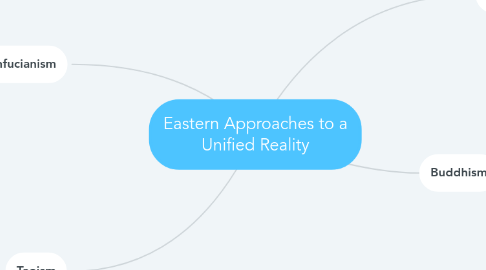
1. Confucianism
1.1. Key Figures: This is the teachings of the Chinese philosopher, Confucius
1.1.1. It places considerable emphasis on family and upholding harmony with others. It is very similar to Taoism
1.1.1.1. Texts: Confucius wrote the Five Classics which are none as the main texts of Confucianism
1.1.1.1.1. Book 1: Book of Change. Talks about the philosophy of change, yin and yang, and the unity of the universe
1.1.1.1.2. Book 2: Book of Songs. Shows how poetry conveys human feelings.
1.1.1.1.3. Book 3: Book of History. Speaks about the major events in history and how to build an ethical government.
1.1.1.1.4. Book 4: Book of Rites. Explains the social form and traditions of the Zhou Dynasty
1.1.1.1.5. Book 5: Spring and Autumn Annals. Relates what happened in the years between 771 - 476 BCE.
2. Taoism
2.1. Taoism is the philosophical way of living in harmony with Tao which means "path."It is believed that Tao is the driving force behind everything.
2.1.1. The Nature of Ultimate Reality: Taoism teaches its followers to live for their selves. To not practice good moral codes for Heaven or for rewards, rather to be good and true for one's own self. This is to ensure that a Taoist takes responsibility in how they treat themselves and others.
2.1.1.1. What is Self: Taoist believe that harmony exists when the human nature aligns with the rest of nature. That one must strive to bring their moral conduct to one that is natural rather than one that is adopted through social interference.
2.1.1.1.1. The Meaning of Life: The purpose of life for a Taoist is that they achieve self-peace. That they respect themselves and love themselves which, ultimately leads them to value all types of life.
3. Hinduism
3.1. Hinduism is a religion that teaches an ultimate reality. The goal of a Hindu is to achieve self-realization through understanding the ultimate reality.
3.1.1. Relationship Between Mind and Matter: Hindu's believe in the Mind Over Matter theory by believing in reincarnation. They believe that the soul will go through many births until are karma's have been satisfied and moksha is attained.
3.1.1.1. The Nature of Ultimate Reality: Hindu's believe in an Unmanifest Reality which counts as their God. They believe that the universe undergoes many changes and cycles, evolving, preserving and destruction
3.1.1.1.1. They believe that they themselves are only one small part in the larger scenario of the universe. That they must experience Reality spiritually, usually with the guidance of a guru.
4. Buddhism
4.1. Buddha believed that reality is ever-changing and that meditation is the only way to truly understand reality and to achieve a Buddhist end goal: to become one with the universe
4.1.1. Nature of Ultimate Reality: There are four noble truths that a Buddhist must contemplate on to reach the heights of their contemplation. The four truths are basically realities that lead the Buddhist to enlightenment.
4.1.1.1. What is Self: They believe that the self should be disciplined from it's unwanted desires through compassion and the act of humbling oneself. Ignorance is likewise extinguished by allowing the mind access to wisdom. Self-discipline is an important part of this religion
4.1.1.2. Dukka: suffering is a part of life
4.1.1.3. Samudaya: the cause of suffering is ignorance
4.1.1.4. Nirodha: there is an end to suffering but it is achieved when desires are disciplined
4.1.1.5. Marga: the path that leads out from suffering
